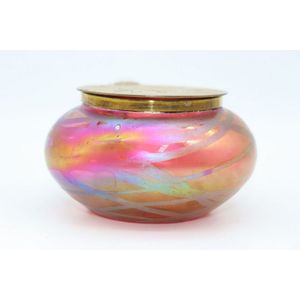Iridescent Swirled Glass Trinket Box with Cherry Blossom Lid
Art Nouveau glass trinket box, iridescent Loetz style swirled glass with brass and silverplate cherry blossom decorated lid, impressed registered design numbers to underneath lid
You must be a subscriber, and be logged in to view price and dealer details.
Subscribe Now to view actual auction price for this item
When you subscribe, you have the option of setting the currency in which to display prices to $Au, $US, $NZ or Stg.
This item has been sold, and the description, image and price are for reference purposes only.
- Art Nouveau Period - The Art Nouveau period was a cultural movement that emerged in the late 19th century, and was characterized by its emphasis on natural forms, flowing lines, and a decorative, ornamental style. Art Nouveau was a reaction against the ornate and heavily stylized designs of the previous era, and sought to create a new, more organic aesthetic.
Art Nouveau was characterized by its use of sinuous, curving lines, as well as a focus on natural elements such as flowers, vines, and other organic shapes. Art Nouveau designers sought to create a total work of art, in which every element of a building or object was designed to be harmonious with the overall design.
Some of the most iconic examples of Art Nouveau design include the Paris Metro entrances designed by Hector Guimard, the works of the artist Alphonse Mucha, and the architecture of Victor Horta in Brussels.
The Art Nouveau period was at its peak between 1890 and 1910, but began to decline in popularity by the start of World War I. However, Art Nouveau remains an important influence on design and art to this day, and continues to be celebrated for its emphasis on natural forms and decorative style. - Registered Design - During the period 1842-1883 the Patent Office issued a diamond mark along with the registration number when a design was registered.
Besides indicating that the design had been registered, a diamond mark offered the buyer the reassurance of knowing an item was of British design. It assured the person registering the design a degree of protection from copying.
The mark was created to identify the type of material used (known as the class), how many items were included, (sometimes known as bundles or packages), and the date of registration.
On the diamond mark the year of registration is shown along with the month code. However, there are two ranges of year codes; 1842-1867 and 1868-1883. By looking at the design of the diamond mark you should be able to determine the correct year from the design of the diamond mark and the placing of the day number.
Source and further information: http://www.nationalarchives.gov.uk/records/research-guides/reg-design-diamond.htm - Irridescent Glass - Iridescent glass has a shimmering or rainbow-like appearance due to the way it reflects light. It is created by applying a thin layer of metal oxides to the surface of the glass while it is still hot and malleable, which then creates an interference effect that produces a range of colours as the light reflects off the surface. The exact colours and patterns created by iridescent glass depend on the specific types of metal oxides used and the techniques used to apply them.
Iridescent glass was first developed in the late 19th century, and quickly became popular for use in decorative art glass and stained glass windows. Some of the most famous examples of iridescent glass were created by artists such as Louis Comfort Tiffany and his studio, who used it extensively in their distinctive lamps, vases, and other decorative objects.
This item has been included into following indexes:
